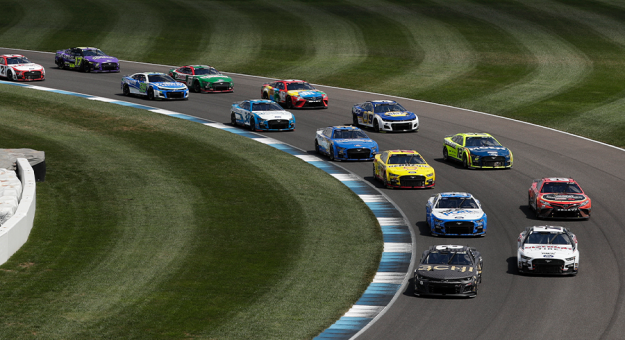It’s expected on any road course, specifically on restarts, that aggression levels will skyrocket.
For every competitor, it’s an opportunity to make up a tremendous amount of ground before the field stretches out.
However, after Sunday’s NASCAR Cup Series race at Indianapolis Motor Speedway, this question comes up once again:
What’s the line of aggression?
That aggression was seen at the green flag, when the field of 38 went barreling into turn one.
Even though Justin Haley spun harmlessly out of the first corner, it was a sign of things to come during the Verizon 200 at the Brickyard.
Multiple drivers had issues, including Brad Keselowski, Ross Chastain Denny Hamlin, Chase Elliott, Kyle Larson and Aric Almirola.
A restart with three laps to go, took the word aggression to a different level.
The pack, sometimes eight-wide heading into a tight turn one, unraveled, with fenders caving in, brakes smoking and cars spinning.
Points leader Elliott’s day became dim, after getting tagged from behind while running second.
Elliott’s Hendrick Motorsports teammate William Byron was among those collected in the mess.
More drivers spun, including Austin Dillon, who brought out the final caution of the day after getting stuck in a gravel trap.
On a green-white-checkered restart, with drivers banging fenders left and right, another contender, Ryan Blaney, was eliminated when his car was contacted from behind.
With all that going on, Trackhouse Racing’s Ross Chastain passed everyone to race side-by-side with leader Tyler Reddick.
The only issue for Chastain?
He missed turn one and escaped the melee by taking an access road.
Though NASCAR penalized Chastain 30 seconds for the shortcut, it was the cherry on top for an absolute mess.
Second-place finisher Austin Cindric was baffled after the race.
“It’s easy on paper, right? Oh, my gosh, I feel like we probably deserved 10th at best today,” Cindric said. “There werea few things I was good at but I needed the whole track to do it and I kind of struggled a bit, probably a little lower than my expectations were today, but those restarts, survival, holy crap. All I can say is ‘wow.’ There’s no other sport, no other form of racing other than NASCAR that you’re going to get that.”
Cindric described the final restart, where he felt he didn’t have much control over his Team Penske Ford.
“Pretty much everybody else ended up in the grass that was in front of me, and I got shoved — pretty much from the moment I touched the brake, I was shoved all the way through the brake zone,” Cindric said. “The car was quiet. I had the rear axle locked, the front axle locked. I couldn’t stop because I had four guys behind me pushing. It was pretty crazy. Definitely something you can’t do as the steer front goes in the car, so not surprised but a bit taken aback for sure.”
The aggression comes after last year’s chaotic race on the Indianapolis Motor Speedway Road Course, where sixcautions and a major multi-car pileup highlighted the event.
Despite the chaos behind him, Reddick remained calm en route to claiming his second victory of the season.
“I had to be perfect on my restart,” Reddick said. “I kind of had to make sure that I was a little bit aggressive at blocking drivers to the far right going into turn 1 because it seemed like that would work out in the first couple of rows for those drivers making that move, but thankfully I did and was pretty good in the braking zone to hold them off, too.”
The line of aggression was pushed multiple times during Sunday’s event, and it may have happened due to the nature of the Next Gen car.
“Well, certainly with this car, the edge is much sharper. It’s like a cliff,” Reddick said. “With the old car it was a bit more rounded. You could get up to that edge and slide past it and bring it back. I think with this car, if you can focus enough, you can get to that edge and not crash past it, but it certainly is happening much quicker than it was with the old car for a number of reasons. Whether it’s the physical body on the car, how it’s shaped, there’s less quarter panel, how the diffuser works, and then the sidewall of the tires being different, too, really plays a role in that.”
Reddick felt that the flat characteristics of the IMS road course also played a role in the incidents on track.
I just think with a flat track like this and how this car gets — I wasn’t in dirty air for many laps today, but certainly there was a pretty big difference whether in clean air or dirty air, so I’m kind of glad we were a little bit on the loose side out front and by ourselves because it allowed us to work dirty air pretty well,” Reddick said. “These cars are really edgy, and it’s very easy once you get past that limit that you just end up blowing past it and spinning out.”
As drivers continue to find the fine line between on the edge and crashing with the Next Gen car, their next big test comes in two weeks at a natural terrain road course in Watkins Glen (N.Y.) Int’l.
